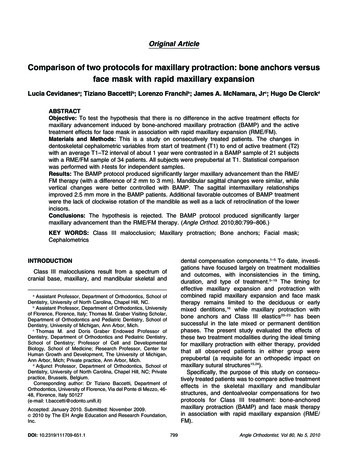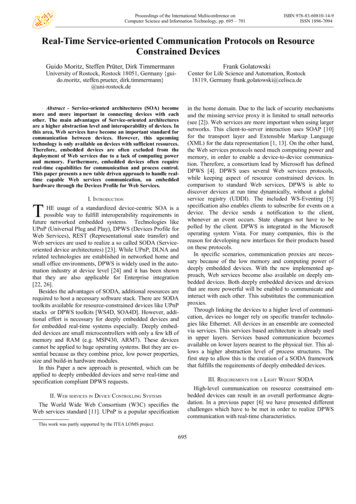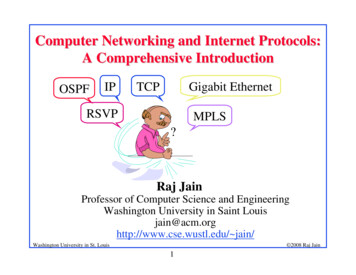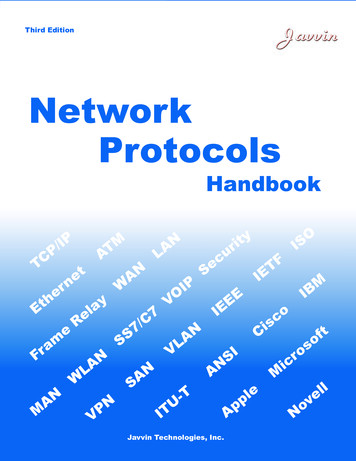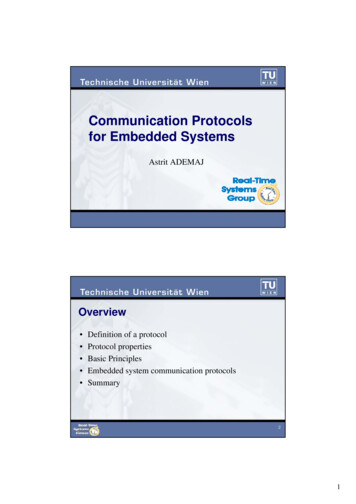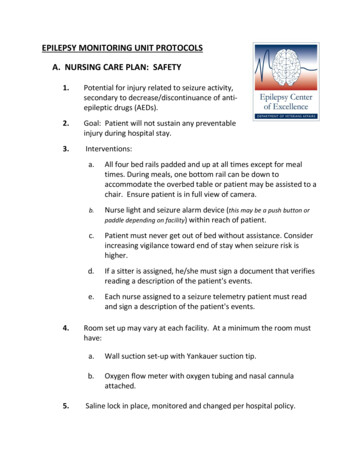
Transcription
EPILEPSY MONITORING UNIT PROTOCOLSA. NURSING CARE PLAN: SAFETY1.Potential for injury related to seizure activity,secondary to decrease/discontinuance of antiepileptic drugs (AEDs).2.Goal: Patient will not sustain any preventableinjury during hospital stay.3.Interventions:4.5.a.All four bed rails padded and up at all times except for mealtimes. During meals, one bottom rail can be down toaccommodate the overbed table or patient may be assisted to achair. Ensure patient is in full view of camera.b.Nurse light and seizure alarm device (this may be a push button orpaddle depending on facility) within reach of patient.c.Patient must never get out of bed without assistance. Considerincreasing vigilance toward end of stay when seizure risk ishigher.d.If a sitter is assigned, he/she must sign a document that verifiesreading a description of the patient's events.e.Each nurse assigned to a seizure telemetry patient must readand sign a description of the patient's events.Room set up may vary at each facility. At a minimum the room musthave:a.Wall suction set-up with Yankauer suction tip.b.Oxygen flow meter with oxygen tubing and nasal cannulaattached.Saline lock in place, monitored and changed per hospital policy.
B. NURSING CARE PLAN:PATIENT EDUCATION1. Knowledge deficit related to seizure telemetryprotocols.2. Goal: Patient will verbalize understanding ofseizure telemetry protocols and will agree to complywith these protocols. Depending on the facility, the patient may be asked tosign the Education Nursing Care Plan.3. Interventions:a. Ensure the patient knows how to use the event alarm. Explain tothe patient that this device should never be pushed unless thepatient is feeling different, having an aura, or feels like an event iscoming on or has already started. If the patient will have family orfriends staying in the room or frequently visiting, make sure theyknow how to push the event alarm device as well in case theywitness an event and the patient is unable to press thebutton/paddle.b.Depending on the facility, some patients may be asked to pressboth the seizure alarm device and the nursing call light.c.Instruct the patient not to get out of bed without assistance.Explain the need to have someone with the patient if an eventoccurs.d.Inform the patient that the decrease or removal of AEDs may resultin more frequent or different types of types of events.e.Inform the patient that he/she cannot shower or get any of theequipment wet. The patient may have a "sponge bath" with a dampcloth. Male patients will not be permitted to shave because of theplacement of electrodes on the facial margins. The patient will notbe able to take the equipment off. Once placed, the batterypack/amplifier must stay with the patient at all times. Explain the
need to have button, snap or zip up tops tofacilitate clothing changes. The patient willnot be allowed to remove anything over thehead once the electrodes are in place.f.Remind the patient that all medications willbe provided by the facility and the patientshould not take anything from his/her ownsupply.g.Instruct patient to keep the padded bed rails up at all times exceptat meal times or when assisted out of bed.h.Remind the patient that the camera and audio is on at all times.Also, there is a microphone in the room and sound is beingrecorded simultaneously with the digital image.i.Inform the patient that there is no smoking or chewing tobaccoduring monitoring. Nicotine patches are available. Inform thepatient that there are no food or fluid restrictions unless ordered byprovider. The patient may have alternative meals, snacks anddrinks brought in by family or friends. Inform the patient that thereis to be no gum chewing or chewing of hard or chewy candy thatmight be a choking hazard or confused with oral automatisms.Explain to the patient that he/she will not be allowed to haveaccess to any sharp objects while being monitored i.e. knitting orsewing needles, razors, and pins.The information above was explained to the patient and questions addressed. Thepatient verbalizes understanding and agrees to comply with the seizure telemetryprotocol.
SEIZURE TELEMETRY STANDING ORDERSIctal Spect Patients:INTRAVENOUS ACCESSAll ictal spect patients will have a 20 gauge saline lockwithout a J loop (increases time it takes forradioactive Isotope to reach patient’s bloodstream) ordered and placed uponadmission to the VA and maintained in accordance with hospital policy bythe RN and Patient Support Team for the entire admission.PREGNANCY TESTAll females with reproductive capacity need to have pregnancy tests prior toinjection.Surgical Grid Patients:INTRAVENOUS ACCESSDependent on the facility, a PICC line may be placed in the GRID patient. Ifplaced, the PICC line is maintained in accordance with hospital policy by theRN and Patient Support Team for the entire admission.Grid MappingOrders for benzodiazepines are MD dependent. Some facilities may havestanding orders for lorazepam at the bedside.
All Seizure Patients:CONSTIPATIONImmobility can increase the risk of constipation bydecreasing gastrointestinal motility. Patients in the EpilepsyMonitoring Unit are confined to their bed for most of theadmission, and are at increased risk for constipation. The RNshould assess the patient thoroughly and then determinethe proper intervention based on the patient’s input and laxative guidelines.Laxative medications will be available to the chronic or acutely constipated patient.EXERCISEPedal exerciser or similar approved device to be used PRN for exercise.BENZODIAZEPINESUse of benzodiazepines is MD and facility dependent. Some facilities may have astanding order in place for lorazepam to be used as needed. Contact theNeurology Service and inform the EEG technologist if a benzodiazepine is used.SLEEP DEPRIVATIONSleep deprivation is frequently ordered to help induce events. The timeframe for the sleep deprivation starts at the time the order is written unlessotherwise specified. The time span for sleep deprivation is dependent on the MDand the facility. Generally, there are no food, fluid, or caffeine restrictions duringthis time unless so ordered.DIPHENHYDRAMINEUse of diphenhydramine for scalp itching is MD and facility dependent. Somefacilities may have a standing order in place for diphenhydramine to be used asneeded.
A. NURSING CARE PLAN: SAFETY 1. Potential for injury related to seizure activity, secondary to decrease/discontinuance of anti-epileptic drugs (AEDs). 2. Goal: Patient will not sustain any preventable injury during hospital stay. 3. Interventions: a. All four bed rails padded and up at all times except for meal times. During meals, one bottom rail can be down toFile Size: 409KBPage Count: 5



